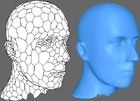
Modeling across scales. In many systems, the dynamics at the
one length or time scale affects the response at other scales.
This occurs from the atomic scale, such as in biomolecules, to
the continuum levels as in the structure of materials, and from
the nanosecond time scale to the second time scale. The range
of problems for which this occurs is very broad, ranging from
engineering systems and geophysical flows, to problems involving
imaging, as well as biological systems. Basic research on fundamental
techniques for the modeling and computation for such systems is
one of the objectives of CIMMS. This is done in the context of
specific examples with efficient computational objectives in mind.
Averaging, the quasicontinuum method, time-frequency decomposition,
and model reduction are examples of techniques that CIMMS will
foster.
Computational analysis. The development of computational tools
for the effective computation of multiscale systems is one of
the central themes of CIMMS. Multiscale algorithm development,
hierarchy based algorithms, and techniques based on subdivision
surfaces, wavelets, curvelets etc, are examples of tools where
additional fundamental research is needed. One of the objectives
of CIMMS is to bring together workers in the physical modeling
aspects of multiscale systems with those from the computational
community. This rich mixture of methodologies will be key to further
success.
Model validation. When one is simulating complex multiscale
systems, it is critical to develop methods for validating the
computation. Since experience shows that one scale can dramatically
influence other scales, the checking of the validity is a basic
and important question. The resolution of these problems is expected
to involve tools such as error analysis and interval arithmetic
across scales. Part of the complication is that often the answer
will depend on the measure of validation one uses; a model may
predict some gross quantities very well but fail at another scale
of fidelity, so that a systematic way of passing through scales
and keeping measures of validation is important.
Uncertainty management. Realistic models of systems must
take into account the fact that the models themselves as well
as the parameters that are used may be uncertain. The uncertainties
can be one of neglected details at a certain scale as well as
stochastic effects. Techniques from linear control theory have
made considerable progress on such methods and another objective
of CIMMS would be to encourage the development of such methods
for nonlinear systems and their application to both modeling across
scales as well as to computational analysis.







